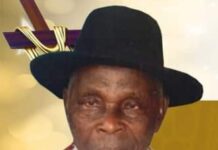History was made in Lagos by the Centre for Black and African Arts and Civilization (CBAAC), a parastatal of the federal Ministry of Information and Culture, when the centre mounted a giant outdoor artistic symbol of Queen Idia of Benin at Marina, Lagos. The Queen Idia mask represents FESTAC ’77 and will forever remain the symbol of African history, culture and arts. Edozie Udeze , who witnessed the ceremony writes on the significance of this imposing project in the annals of history in Africa
NOT too many people knew why the federal government of Nigeria in 1977 alongside the 59 black and African countries that participated in the Second World Black and African Festival of Arts and Culture (FESTAC ’77) chose the mask of Queen Idia of the Benin kingdom as the symbol of African cultural identity.
Even as the Centre for Black and African Arts and Civilization (CBAAC) was unveiling the outdoor installation of the Queen Idia mask last week in Lagos, that same question of the symbolism of this great woman of history resurfaced. CBAAC was immediately established by the federal government after FESTAC ’77 to cater for the numerous historical relics of that monumental festival. Today it is one of the foremost Pan-African Centres in Nigeria under the Federal Ministry of Information and Culture.
However, the Queen Idia mask had been kept indoors by CBAAC for a long time. But the current Director-General, Oluwabunmi Ayobami Amao in her wisdom decided to do the impossible by making the giant artistic mask visible in front of the CBAAC office on Broad Street, Marina, Lagos. A giant transparent glass casing has been erected to house Queen Idia. It is to further celebrate her place, her life and importance in the history of Nigeria and to a large extent, Africa.
At the unveiling, Amao said: “It was under the staircase for a long time. There, its great significance was not defined. But at a point I decided it was time to bring it out. From the very moment I came here as the DG, I told myself that this mask must come out. We needed to showcase it, let the world see this beauty and what it stands for”. For this reason, the project was set in place by this Amazon of culture, a true lover of African history.
For her, CBAAC is not just for Nigeria and Nigerians, it is for the 59 black and African countries that own FESTAC ’77. It is indeed for all blacks wherever they may be domiciled. “I feel great about the symbol. It shows that anywhere you put a woman, she will excel. Queen Idia excelled, hence she has come to dominate history as a symbol of African cultural identity. It is a great honour for her and for women”, she said. “God has given us special gift. We know how to handle issues but all we are asking government is to give us more support. We need that 35 percent representation in government as promised us by the federal government. That way, we will do more, achieve great strides to move this country forward”.
She said further, “let us even start with having the first female state governor in Nigeria and you will see how far we can go. Eleen Sirleaf, the former president of Liberia did well. In Information and Culture ministry, I am the only woman director – general. This is lope-sided. We need more women to have more voices”. Amao is a lover of culture who began her political career under the Ajimobi-led government in Oyo State. Although an Accountant, she has lived almost all her public life promoting the rudiments of Nigerian and African cultural heritages and values.
So as the director-general of this great Pan-African centre, she has been able within a short time to breathe life into the establishment. She has been in the forefront of ensuring that all aspects of the mandate for which CBAAC has been put in place are followed. At the moment, she is geared towards reawakening the interest of the public in the activities of the centre.
In addition, she is highly innovative, creating more museums, displaying all the relics and artefacts used by different countries and nation-states at the FESTAC ’77. As it is today, the centre glitters with varieties of artistic emblems symbolic of a centre of its stature and caliber. It is really amazing to see a new face of CBAAC where African heritages, tangible and intangible, adorn spaces.
Even then, Amao believes that if proper entreaties are made, African nations will begin to show renewed and concerted interest thereby paying their statutory dues for the upkeep.
Queen Idia in history
She was born in the 15th century in Uzeghudu. It is in an area of Isi or Oronsaye in Eguae. Idia got married to Oba Ozolua of the Benin kingdom early enough. Oba Ozolua reigned around 1481 AD. Ozolua was a powerful Oba and within the period of his reign, Idia took time to fortify her positions; ensuring that her husband became a strong ruler. She was instrumental to Oba Ozolua becoming a renowned warrior that he was nicknamed the conqueror. Under his reign, Benin kingdom greatly expanded its frontiers through extensive warfare and campaigns.
Idia was the mother of Oba Esigie of Benin who took over from his father Ozolua. Esigie ruled from 1504 to 1550. At that time, Idia played a very significant role during his reign. She was a great soldier, a warrior, a heroine, very fearless and daring. She fought strongly for Esigie to defeat his closest rivalry and brother Arhuaran to emerge as oba.
It was Oba Esigie who made her the first Iyoba (queen mother) of Benin when he mounted the throne. Idia led Benin army on several other expeditions as far as the Idah kingdom in today’s Kogi State. As the 17th Oba of Benin therefore, Esigie had the formidable support of the army with the strong backing of his mother Idia who was the commander of the soldiers.
Today, the title Iyoba of Benin is an important female title holder in the chieftaincy system of the kingdom. So as it is, the obas now wear the carved ivory pendant masks representing the Iyoba. It is most significant at ceremonies and it is believed to ward off evil spirits from the kingdom.
Queen Idia greatly used her magical powers and knowledge of medicine to help her son overcome his enemies. The queen mother equally began Ekasa, a special dance which still forms part of the royal ceremonies in Benin. Idia’s tomb is located at Egua-Iyoba, Benin City.
In history, there have been several representations of Idia by different artists in form of masks and sculptures. Unfortunately, the original copies were stolen by the British army during the 1897 Benin expedition. They are now held in British and other museums around the world. This has been a source of diplomatic squabble between Nigeria and Britain since time. Most annoying is that most of the art works carted away from Benin in 1897 have been disposed of by Britain through series of auctions.
On the whole, with a palace built for Queen Idia in Lower Uselu, which till date serves as the final resting place, for every Iyoba, this way, history has somewhat carved a place for her in the history of Benin. And today too African nations have recognized her significance by elevating her to this level.
Source: The Nation












